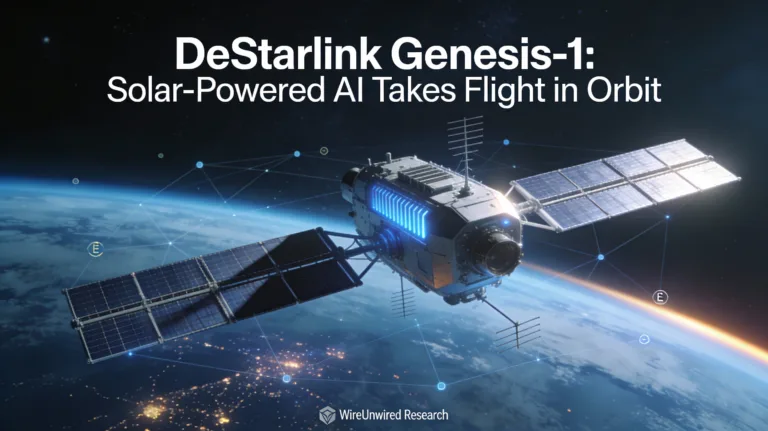Are we witnessing the birth of Physical AI—AI systems that fundamentally understand and manipulate the real world?
This question was at the heart of discussions at Carnegie Mellon University’s campus this September as the AI Horizons 2025 event unveiled advances in AI physical deployment. The conference signified a pivotal moment for the field: a transformation from purely virtual intelligence to embodied AI systems interacting with—and adapting to—the messy complexity of the real world.
Physical AI refers to any system that interacts with and adapts to our physical world. Unlike digital AI, physical AI involves sensing, reacting and making decisions in real-world environments.
— Carnegie Mellon University (@CarnegieMellon) September 10, 2025
💡Example: CMU's BrickGPT, which uses #AI to turn words into buildable designs. pic.twitter.com/gKFOeKmj9F
What all happened at AI Horizons 2025 event ?
At AI Horizons 2025, Carnegie Mellon University showcased the rapid advances that define the “Physical AI” era: artificial intelligence systems directly controlling and collaborating with robotics, autonomous vehicles, manufacturing lines, drones, and more. Unlike traditional AI, which is often confined to purely digital tasks, Physical AI is about real-world agency—from vision and manipulation to adaptive, autonomous decisions.
CMU’s(Carnegie Mellon University’s) experts and partners highlighted how this shift is already taking shape:
Autonomous Manufacturing: Robots and AI that restructure production lines in real time.
Surgical Robotics: New systems enabling precision and safe human-robot collaboration in surgery.
Infrastructure Monitoring: AI-powered drones and sensors proactively maintaining critical infrastructure like bridges and grids.
Agricultural Automation: Field robots optimizing crop yields through real-time analytics.
Speakers at the event emphasized that Physical AI isn’t just about programming robots—it’s about creating systems with intuitive understanding of space, materials, and physics, allowing for autonomous operation even in unpredictable, unstructured environments.
TRENDING
Why Physical AI Matters?
Physical AI signals far more than an engineering upgrade. According to industry analysts, global spending on embodied/vertical AI is projected to reach nearly $47 billion by 2030, with manufacturing, healthcare, transportation, and infrastructure as leading drivers.
From a research perspective, Physical AI tackles the long-standing embodiment problem: the gap between digital-only intelligence and machines that can actually interact with, sense, and shape the physical world. Carnegie Mellon and partner institutions are at the forefront of pioneering approaches—combining computer vision, tactile sensing, machine learning, and robotics engineering.
Strategically, these advances may position the U.S. and its partners for leadership in sectors where physical intelligence is a game-changer, from national defense and resilient infrastructure to advanced manufacturing.
Because Physical AI systems can operate in dangerous or inaccessible environments—like nuclear plants, offshore wind farms, or disaster zones—they could radically expand human capability while reducing operational risks.
How is CMU contributing to the Physical AI Industry ?
While Carnegie Mellon’s expertise is central, the Physical AI surge is global. Stanford University’s Human-Centered AI, Google’s Everyday Robots, and robotics investments by industry leaders all contribute to the competitive landscape. There are even signs that consumer tech giants are eyeing smart home robotics, though official products are yet to be announced.
CMU’s strength lies in combining theory and practice: cross-cutting research, robust real-world partnerships, and large-scale pilots with manufacturers and medical centers.
What we can expect in the upcoming years ?
AI Horizons 2025 spotlighted future challenges and opportunities, especially around safety protocols, ethical frameworks, and scalability. While no official “Physical AI Safety Institute” has launched yet, conversations at CMU and at the summit highlighted the need for standards and oversight as embodied AI moves into hospitals, factories, cities, and homes.
Expect to see more pilot programs and regulatory collaboration through 2026, with 5G and edge computing unlocking distributed, real-time decision making—from traffic systems to coordinated disaster response.
What do I think : The conclusion.
I predict that Physical AI will likely be the most significant leap in robotics since the industrial revolution. Groundbreaking applications, such as adaptive manufacturing, human-centered surgical assistance, and infrastructure-monitoring swarms, all point toward a future where AI doesn’t just understand data—it navigates and acts in the world.
What’s fundamentally different is how Physical AI learns and adapts, bridging the gulf between static automation and dynamic, self-improving systems. As a result, robotics could become accessible even for smaller manufacturers and healthcare providers—democratizing capability previously reserved for the world’s largest organizations.
The real question is no longer ‘if’ Physical AI will transform industry and society, but ‘how soon’ our frameworks for safety, ethics, and regulation can keep pace.
Discover more from WireUnwired Research
Subscribe to get the latest posts sent to your email.




